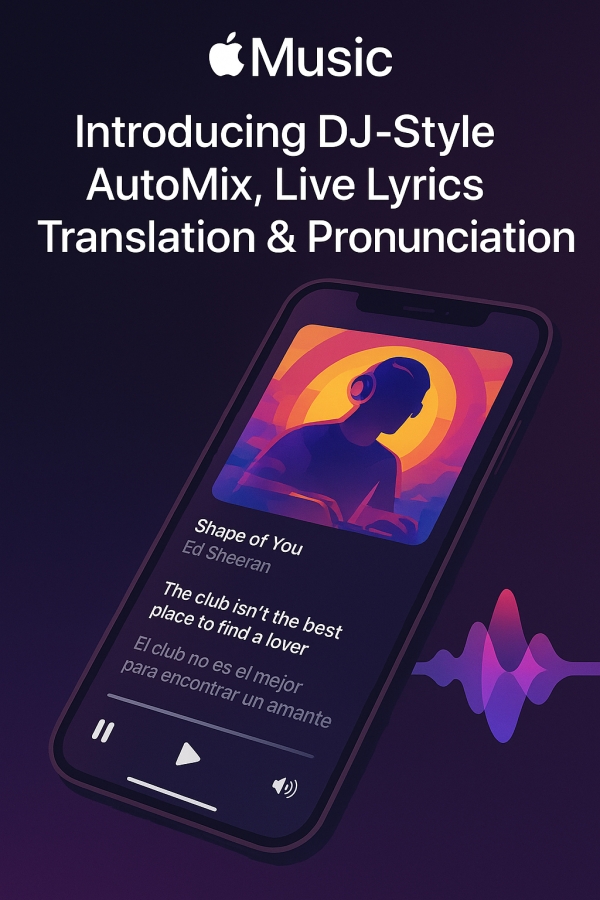Apple Music Levels Up: DJ-Style AutoMix, Live Lyrics Translation & More in iOS 26
Music streaming is no longer just about selecting songs and pressing play. With Apple’s iOS 26 rollout, Apple Music is pushing forward with new features that aim to deepen listening, break down language barriers, and blur the line between a curated DJ set and your personal playlist. Among the most significant upgrades: AutoMix, Lyrics Translation and Pronunciation, plus a host of companion features that make the experience more seamless and global. Here’s what’s new, why it matters, and what to watch out for.
What’s New: AutoMix, Lyrics Translation & Pronunciation
AutoMix: DJ-Style Transitions
One of the headline additions is AutoMix. Designed to make transitions between songs smoother, AutoMix analyses audio features like tempo, beat, and key (using Apple’s AI/machine learning tools) and dynamically mixes one track into the next. The idea is to avoid awkward silences or sharp jumps — the way a skilled DJ would make sure the dancefloor stays alive.
Unlike the simple “crossfade” that many streaming services offer (where one track fades into another), AutoMix employs time-stretching and beat matching, letting tracks overlap in rhythmically compatible ways and maintain a continuous flow.
Lyrics Translation and Pronunciation
Another major set of features aims at making music more linguistically accessible:
-
Lyrics Translation: Users can now see translations of lyrics into their native or preferred languages. This helps in understanding the meaning behind songs in foreign languages — whether you're exploring world music or simply listening to a track you like but don’t fully understand.
-
Lyrics Pronunciation: Alongside translation, Apple is also introducing pronunciation aids. This assists in singing along properly (or learning) when lyrics are in languages you don’t speak fluently. Important for phonetics, cultural expression, etc.
These features are made possible by combining machine learning with human-expert oversight, ensuring that nuance, emotion, and cultural context aren’t totally lost in translation.
Why This Matters
These aren’t just small “nice to have” updates. They shift how we engage with music in several meaningful ways:
-
Enhanced listening experience
AutoMix turns passive listening into something more immersive. Whether you’re working, walking, driving, or hosting, the flow matters — abrupt transitions or silence can break the mood. AutoMix keeps you “in the moment.” -
Globalization & inclusivity
With streaming, geography is no longer a barrier — but language still is. Being able to read translations and see pronunciation helps users access and appreciate music from cultures and languages beyond their own. It makes music more universal. -
Learning & appreciation
These features also serve as tools for language learners, world music fans, and even karaoke enthusiasts. Pronunciation tools and real-time translations can help with understanding lyrics, cultural references, or metaphors you might otherwise miss. -
Competition & innovation in streaming
Features like AutoMix reflect how streaming services are pushing to differentiate themselves. It’s not enough anymore to just have large catalogs; it’s about how you deliver, how you enhance, how you let users connect. Apple spurs competition, which typically results in better features for everyone.
Potential Limitations & Things to Watch
All new features come with trade-offs, and user feedback already suggests some issues and caveats:
-
Cuts in songs / truncated transitions: Some early testers say AutoMix sometimes cuts off portions of tracks (especially the end of a song or beginning of the next) too early, sacrificing full verses or intros in favor of a smooth transition.
-
Genre/playlist restrictions: AutoMix may work better in certain genres or playlist types. Songs with wild tempo changes, dramatic intros or outros, or non-standard musical transitions might be harder to mix well. The algorithm has limitations.
-
Translation limits: While translations are powerful, initially, they may only cover certain language pairs. And nuance (slang, cultural idioms) can be hard to preserve even with experts refining them. Users may find some translations less polished.
-
Device / regional availability: As with many new Apple Intelligence features, availability depends on device capability and region. Some older devices may not support the new AI-driven features, or certain languages may not be available immediately.
Broader Context & What It Suggests for the Future
These upgrades give us hints about where music streaming might be headed.
-
More AI in creative delivery: AutoMix shows that AI isn’t just for recommendations or playlists — it’s involved in how the music sounds to the listener. We can expect more tools that alter or augment playback (remixes, dynamic EQ, spatial audio, etc.).
-
Cultural bridging tools become core: Lyrics translation & pronunciation suggest that global music markets will increasingly prioritize understandability and cultural resonance — not just discovery but comprehension. This ties into the rise of global hits (K-pop, Latin, Afrobeats, etc.).
-
User control vs automation balance: Users like automation (so things are smoother, easier), but also want control (keeping full songs, not skipping intros, preserving original album experiences). Apple and others will need to balance those.
-
Hardware & software integration: Features like “Sing” allowing your iPhone to act as a microphone when paired with Apple TV, visual effects, etc., show Apple building into their ecosystem. The software features are tightly coupled with devices.
Final Thoughts
Apple Music’s introduction of AutoMix, real-time lyrics translation, and pronunciation features marks a meaningful step forward in how we listen to and understand music. It shows that streaming isn’t just about what’s next in the queue, but how we transition between tracks, how much of the content we can absorb, and how global our musical identities can be.
For many users, the result could be more immersion, more connection, and more joy — whether you’re exploring foreign artists, belting karaoke in your living room, or simply letting music carry you through your day without interruption. That said, perfection isn’t here yet: occasional truncations, genre limitations, and device restrictions may temper the experience for some. But on balance, these are exciting innovations.
Learn more at APPLE


